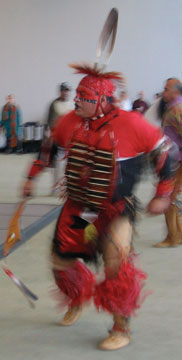The Native American Student Society (NASS) held their first official Native American Pow Wow this past Wednesday, October 27 in the Campus Center Ballroom.
According to Amy Denouden, Faculty Advisor for the NASS, a Pow Wow is a cultural celebration, where people come together to pray, dance, honor their ancestors, and recognize the importance of the Native American communities that exist in the United States today.
The Pow Wow kicked off at eleven thirty with a prayer on the Campus Center Lawn held by Ricky Smith who is part of the Anishanabe tribe at the White Earth Reservation in Minnesota. Following the prayer, the Pow Wow migrated to the Ballroom where Native American and South American indigenous arts and crafts were sold.
Mr. Starr Curliss was the MC for the event. Starr encouraged the attendees to participate in the dances presented by the Wampanoag Dancers. “Shyness is not accepted,” said Curliss to encourage people to join in for the Wampanoag’s first dance called the “Round Dance.” The Round Dance is an equal dance. People join hands and go around in a circle doing simple steps. “Dancing in a circle links all of us,” said Curliss. The Wampanoag Dancers presented their dances wearing colorful and beautiful outfits, and each dance had different meanings and representations. These dances are meant to be performed at ceremonies on reservations either for fun or religious purposes.
Among the dances presented there was the “Mosquito Dance,” where people danced in pairs holding hands, jumping and giving small kicks in the air without hitting their partner. This was to avoid the mosquitoes. “If you bang each other, then you have a mosquito problem,” said Jim Peters, Executive director of the Mass Commission on Indian Affairs and member of the Masspee tribe. Another dance was the “Stomp Dance” which represents all things that can’t speak for themselves like the stones and trees. The dancers formed a line, following a leader who sings while all the rest mimic what the leader says. They all stomp on the ground to extend part of their spirits to the non-living things.
Although the event was mostly for entertainment, Curliss asked all attendees for a moment of silence and respect as a small, but significant, prayer was made to honor fallen veterans. Five people were singing and playing on a drum over which tobacco was poured after the ceremony culminated. As the drum was played again, the tobacco started bouncing off the drum as if joining the beat of their songs.
The Yarina musical group made an appearance later on in the event as well. The group is formed by four brothers and two sisters who delight their public,wherever they go, with their typical music of their native Ecuador. “Our music reflects the countries of the Andes, which includes Colombia, Ecuador, Peru, Bolivia and Chile,” said Roberto Cachimuel, musician, composer and spokesperson for Yarina.
Yarina was nominated for the Best World Music Category at the Native American Music Awards in 2001. The fusion of charango, sampoñas and quenas (all typical instruments of the Andean region) combined with an electric bass resulted in emotively beautiful music.
Raising awareness of Native American issues in Mass. was one of the main purposes of the event. “We want other tribes in [Massachusetts] and other parts of the country to realize that we are still here,” said Maurice Foxx, Chair of the Commission on Indian Affairs. “It has been kind of important to do these events and participate outside of our communities so that people [are reminded] of the fact that we are here and very active,” Foxx commented on the event.
This is actually the third event the NASS organized on Campus. The first event was in the fall of 2003, where Foxx gave a lecture on sovereignty, and the Wampanoag Dancers performed as well. Last spring there was a panel for Native American women speaking on Native American women’s leadership and activism.
“It is important that Native American students here at UMass to have their presence recognized,” said Denouden. She added, “And it is important that they have a forum and to have their issues and concerns heard.”
“Putting this event together required a lot of hard work,” said Renata Tutko, member of the NASS. “Not all of the members in the club are Native American and it is not about separation, it’s about bringing people together,” said Tutko
Attendees and organizers were very pleased with the outcome of the event. Organizers were happy to raise awareness of Native American issues in Massachusetts and attendees were pleased with the dances, music, and food of the Native American culture.





















































